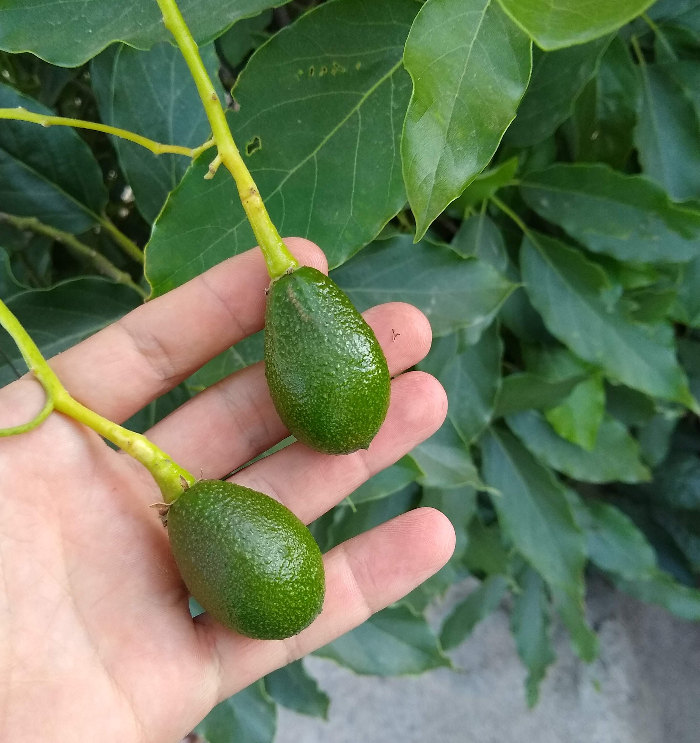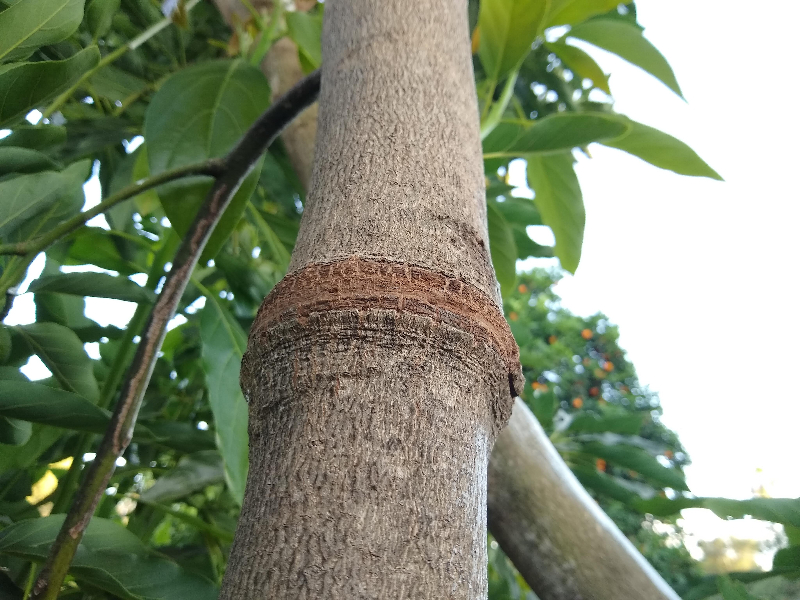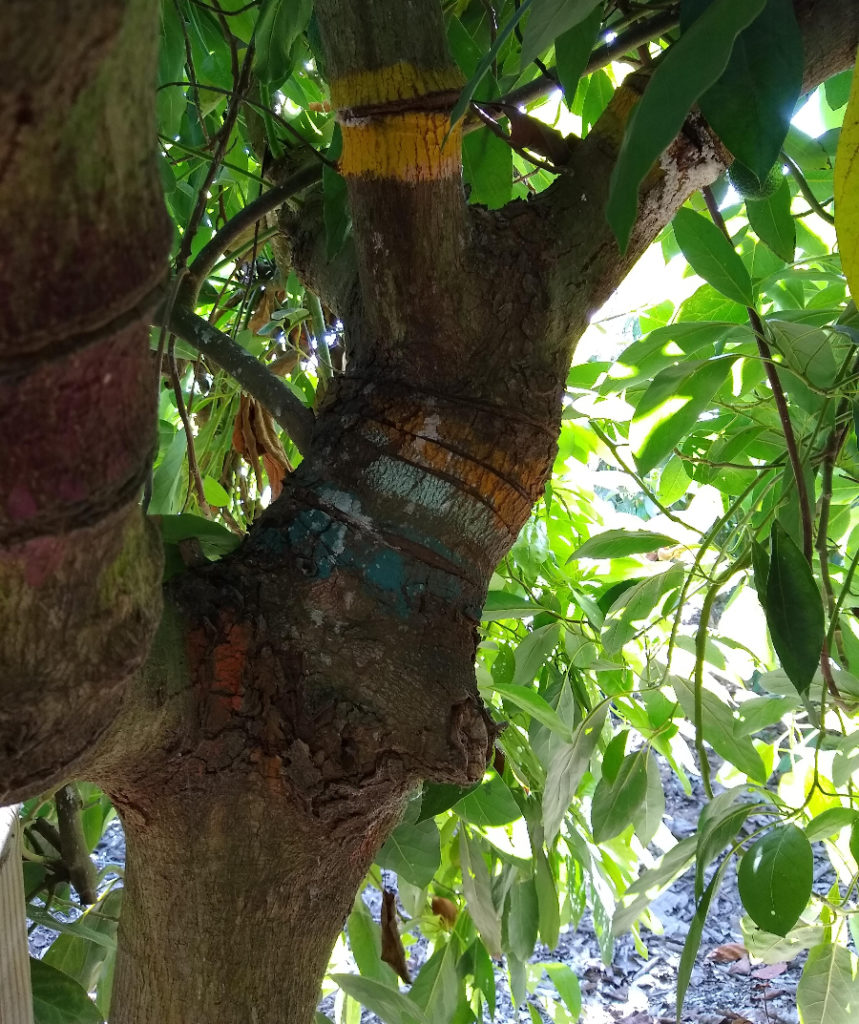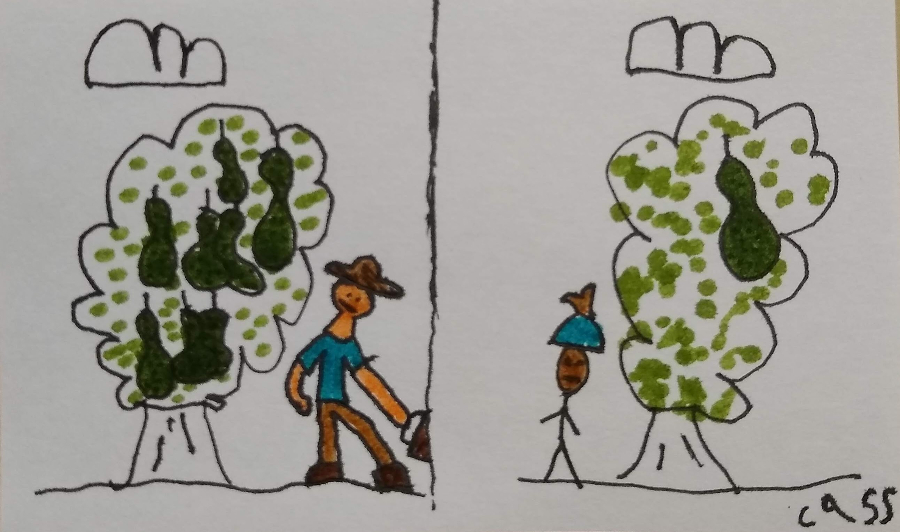Would you rather have 50 avocados from a tree every year or 100 avocados every other year? By nature, individual avocado trees do not bear the same amount of fruit every year, year after year. Their crop load fluctuates, and it fluctuates for many reasons.
I know of three proven ways to reduce that fluctuation, which is called alternate bearing, especially when it is extreme. You can thin the crop when it’s heavy, girdle a major limb or two, and choose avocado varieties that produce more consistently.
Thin crop in “on” years
When an avocado tree is carrying a lot of fruit, people say it’s having an “on” year. When a tree has little to no fruit, people say it’s having an “off” year. If you remove a good portion of the fruit in an on year, the tree will come back with a good bloom and fruitset the following spring, provided no other problems are encountered (such as bad weather). In this way, you can even out the tree’s fruit production.
This is not just botanical theory. Carol Lovatt of the University of California, Riverside put this idea to the test on Hass trees in Irvine. She found that when trees having an on year had their new fruit removed while still small (by August at the latest), they had a higher amount of bloom the following spring compared to other “on” trees whose fruit was not removed.
(See “Alternate Bearing of ‘Hass’ Avocado” by Lovatt in the 2010 California Avocado Society Yearbook.)

Why does this work? If an avocado tree is carrying a fruit on a shoot, that shoot will not grow much and will not make flowers the next spring. Go look at your trees to prove to yourself this is true.
Avocado trees only make flowers on shoots that are not carrying fruit. When you remove fruit, you make available more shoots that can flower the next spring.
A practice with a similar effect is pruning a tree when it’s about to have an on year’s bloom. In other words, if the tree has a low crop and is expected to have heavy flowering in spring, then you can prune it just before or during that bloom (pruning in February or March is usually best), thereby reducing the amount of flowers it will produce (because you’ve cut off many of its flower buds).
Girdle
A second method of managing alternate bearing in avocado trees comes through harnessing their tendency to do so rather than fighting it. This is done by encouraging one half of an individual tree to have an on year while the other half has an off year. You combine the on and off years within a single tree each year. And this is done through a technique called girdling.
Girdling is cutting into a branch in order to interrupt its sap flow. If done right, this girdling causes the branch to make lots of flowers and set lots of fruit.

If you girdle one or two major limbs on a tree, then what happens is you get lots of flowers and fruitset on those limbs while the rest of the tree flowers little or not at all, thereby having an off year.
Then you can girdle the non-girdled branches the next year to ensure that they have an on year while the branches you girdled first have an off year, a year of recovery. So in effect you’ve created alternating production within the same tree, but consistent, moderate production overall from that one tree.
I’ve girdled some of my trees in years past, but I’m not expert on the technique. The technique is in no way experimental for others though. It has been used in avocados in California for over a century. (See “The Effect of Girdling the Avocado” by J. Eliot Coit written in 1921.)
I visited one grove in Ventura County whose Hass trees are all girdled every single year (as long as they’re sufficiently healthy and vigorous). They don’t girdle their other varieties, such as Lamb, GEM, and Gwen, by the way, as those varieties are not as vigorous as Hass.

Here are some presentations with details on girdling avocados, if you’re interested in trying it:
“Girdling in Avocados” by Consuelo Fernandez and Samuel Garibay of Brokaw Nursery
“Pruning and Girdling Methods in High Density Orchards” by Paul Nurre of Oro Del Norte Ranch
See the section called “Develop a two-leader tree” on page 16 in this paper by R. Hofshi, M. Tapia, and M.L. Arpaia
Grow a less alternating variety
The third main way to get more consistent fruiting from an avocado tree is to plant a variety that naturally alternates less. Fuerte was famous for having big swings in production, and then Hass was found to be less alternating, but today there are varieties that alternate less than Hass.
Don’t be misled into thinking that there is an avocado variety whose fruit production doesn’t ebb and flow at all – if you know of one, share this news with me – but some which alternate less than Hass and Fuerte include GEM and Reed.

I say this based on firsthand observations, but it is affirmed by the experience of many others and some well-designed trials. See one report on a trial in Irvine by Mary Lu Arpaia comparing GEM, Hass, and Lamb in terms of alternate bearing in this video of a presentation for a California Avocado Society at 1:28:30.
On the other hand, some varieties that I’ve seen alternate as much or more than Hass, in addition to Fuerte, include Nabal, Lamb, Bacon, and Sir-Prize. These would be varieties to avoid if you are particularly interested in consistent production.
Here it’s important to note when alternate bearing starts in a tree. It usually does not start in the tree’s first few years in the ground. Young trees often have successive, moderate crops. But at some point the conditions will be right for a heavy crop, and it is then that a light crop follows and the alternation has begun. Otherwise, it can start after a bad weather event such as a freeze.
In my observations, the older a tree gets, the more its production alternates, if it has that tendency.
A final note on this: individual trees of the same variety do differ. For example, I know of some Fuerte trees that alternate a lot whereas others don’t alternate very much. So even within the same variety you get individuals that perform differently.
Video
Here I run through my yard showing examples of these three methods of managing alternate bearing:
Are there other ways to manage alternate bearing?
Rootstocks?
Some say that rootstocks influence alternate bearing. For example, the rootstock developed in Israel called Ben-Ya’acov 1 (also known as VC66) is said to have “exhibited a lower tendency towards alternate bearing,” according to Brokaw Nursery, who bought the license for this patented variety. It is plausible that rootstocks would influence alternate bearing since they have been demonstrated to influence other aspects of fruiting (such as precocity and overall yield). However, I haven’t seen the trial data showing this so . . .
Early harvest?
Some say that timing of harvest influences alternate bearing. For example, an avocado researcher in Australia, Tony Whiley, says harvesting a tree’s crop as soon as it is mature (early harvesting) leads to more fruit the following year compared to leaving a tree’s crop on the tree until late in its harvest season. In other words, “On-tree fruit storage is detrimental and contributes to alternate cropping.”
(See “A Conversation with Tony Whiley” by Reuben Hofshi in the 1995 California Avocado Society Yearbook.)
However, while harvest time might be consequential for farmers, who often pick every avocado on an entire tree at one time (strip picking, in the jargon), it seems far less consequential for home growers. Home growers don’t harvest their avocados at one time, early or late. Home growers usually pick a handful or a dozen avocados each week from a particular tree starting at the beginning of its harvest season and continuing until the tree has no more fruit. So, for example, from the moment your Reed avocados start tasting good to you – maybe starting in July – you incrementally reduce its crop load all the way until it’s gone. Timing of harvest seems irrelevant as a method to manage alternate bearing for home growers, it seems to me.
Plant a second tree?
A final idea is to plant a second tree of the same variety so that when one tree is having an on year the other can be having an off year, and vice versa. This way you can have avocados of that variety every year.
It’s a good idea, and I’ve seen it work. One of my friends has a handful of Hass trees and in any given year a few of them are loaded with fruit while a few others have almost none. If you have the space in your yard for this kind of thing, go for it.
But be aware that you may have to initiate the alternation by thinning or entirely removing the crop on one of the trees in order to force it into an off year while the other is having an on year.
Also, there may come a time when the weather conspires to wipe out the crops on both trees. It could be extreme heat or a freeze. Then the trees will both want to come back with a heavy crop as soon as they’ve recovered, and you will have to remove the fruit from one in order to force alternation again.
In conclusion, if it’s important to you to have a single avocado tree that fruits as consistently as possible, then I would recommend doing two simple things. Choose a variety that is known not to alternate bear badly – say, Reed, GEM, or even Hass. And then secondly, never allow it to hold a very heavy crop. That is, if it ever sets a heavy crop, thin a portion of it around June or early July so that the tree grows plenty of new shoots that can flower the following year.
Thank you for your financial support that allows me to write posts like this one. If you’d like to show support for my work at The Yard Posts, click HERE
All of my Yard Posts are listed HERE




Another illuminating topic! Sadly we have eaten all the avocados from your recent offerings. I’m assuming given the summer heat we won’t have any to look forward to in the next week/month/etc?
Hi Mariangela,
As of today, it’s looking like I won’t have anything to offer until the Reeds and Lambs are ready in July. And I’m worried I won’t have enough of those to satisfy everyone so I’m hoping to locate more trees.
I *love* REED! Was introduced to it about 10 years ago at a lunch Gjusta restaurant in Venice Beach and whenever it pops up in the Bay Area I grab them! Have been thrilled to get exposure to other varieties thanks to you!
Excellent article, immediately forwarded it to my husband who insisted on strip picking our REED which produced at least 100 avocados. I ended up making gallons of avocado soup….had to give some away…
I will not be doing that again!
Another subject, we stumped a FUERTE that was too tall and wasn’t productive. It’s growing hundreds of shoots — all close together. Should I thin them?
Thank you Greg.
Hi Lorie,
I would thin the shoots on the Fuerte. You might choose two to four main shoots to come off a large limb or trunk, depending on its size.
Hi Greg,
I just learned about girdling, I live in South Orange county about 1 mile from the coast. Its early February, is it too late to do a girdle on half my Haas ?
The tree is 4 yrs old after being planted in the ground,(was 15 gal size) has many avocados , is 10 ft high and I want to girdle half the tree…. if I girdle now, what is the disadvantage? There are no flowers or new leaves yet.
Thanks
Hi Al,
I’m not sure what the effect would be if you girdled in February. I’ve never girdled outside of October and November and early December. (I’ve settled on November 2 as my magic date for Hass.) October into November has shown to be the most effective window for everyone in Southern California that I am aware of.
However, I know that other dates have been tried, including February. In one trial, February girdling on Hass did result in increased fruit numbers compared to not girdling at all. Check out the trial here: http://avocadosource.com/WAC5/Papers/WAC5_p263.pdf
Thanks for the guidance, I did girdle two branches on the Haas even though I am out of the optimum window….. will see how it does this year which would likely be an “off” year. I also took a chance on my Pinkerton which has been barren the last 2 years and has been somewhat frail. I figured if I prune it significantly and girdle half, somethings gotta give. Otherwise… time to replace the tree.
Thanks for your advice
I would suggest you follow Greg’s suggestion and leave four shoots but I would add that when the shoots are about pencil diameter that you graft other varieties to those shoots. I found that those soft shoots take grafting very easily. Leave one shoot the original and then graft hass or nabal or Pinkerton or other desirable varieties. I have hass and reed growing on one of my large fuerte trees.
Enjoy reading your Posts; always learning something new to keep my attempt at growing an avocado tree a success!
Hi Greg, I just wanted to say I LOVE the title illustration! Please let the artist know they have real talent!
Thanks, Charles! I’ll let him know. That was done by my eight year old. I asked him to draw two avocado trees, one with lots of fruit and the other with very little. He took it from there.
Later he asked why I didn’t draw it myself. “You’re good at making things look realistic,” he said. I told him I like his creativity more.
This is not about avocados – I didn’t know about the exploding poppy seed pods! I have a lot of poppies in my yard and noticed the pods. Guess I need to hang out with them more. Fascinating!
the poppy explosion is real,I save the seed pods of my California Poppies and once in awhile they will pop in my hand as I pick them. The most explosive poppies are the European Yellow Horned Poppies. They really pop. I would grow them as they are very pretty and thrive on neglect, but they are poisonous
Sure enough my 2 trees (Fuerte & Ettinger) are well depicted in the above adorable rendering. You’ve given us great instructions on balancing the crops, but for now I’m letting them be, because one bumper crop is all I can manage. And eat! Learning a lot here about ripening, picking and storing. Thanks!
I have a young Fuerte which is bearing fruit for the first time this year. It’s 6′ tall, and growing like gangbusters. IT was planted spring 2020 from a 15 gallon pot.
It flowered like crazy starting late fall, and fruit really didn’t start setting until maybe March or April. It now has many small fruit of various sizes, from peas size (still) to bigger than a golf ball. I thinking of removing the smaller fruit to allow the tree to focus energy toward the larger, as well as providing opportunity for next year’s crop.
How long can/should one wait to remove fruit such that it allows the tree opportunity to put fruit on those shoots next year? It seems like within the next month or two would be best.
Thanks! Matt
Hi Matt,
If your aim is to get flowering on a shoot that is currently holding fruit, then I’d remove the fruit now (now being late June) on a Fuerte.
If you do, try to tag the shoot(s) that you remove fruit from to see how much they grow compared to shoots holding fruit the rest of this year. Then compare their flowering with the shoots holding fruit.
Great response Greg! I do appreciate learning more rather than just asking about my immediate curiosity.
Last year our Gem had a very large crop and there are still some avocados on the tree, but as of now zero flowers this season. Is this because we didn’t pick them all before spring?
Also for some reason I stopped getting your posts, miss them, so please add me back if I fell off the list.
Hi Alan,
That’s great that your GEM tree had a large crop this year. Still tasting good?
Most likely, the tree didn’t flower this spring because it had a large crop set last year. Almost never do avocado trees (of any variety) have two large crops in successive years, and often a large crop is followed by a very small to zero crop. You can see a GEM tree doing this alternation in my video at the end of my GEM profile here: https://gregalder.com/yardposts/the-gem-avocado-tree-a-profile/
I just sent you a subscription email. You should be able to confirm it to be added back onto the list. You might check your spam folder if you don’t see it in your inbox.
Yes Greg, still delicious. Read your Gem post and it was the best I’ve ever seen on Gem. Keep up your amazing work and positivity. You are a great teacher and generous sharer of information!
Great post. I’m about to experience this with my Fuerte, which had a banner year 2021-2022. I picked the last fruit just 4 days ago. Now, it only has a fraction of that setting, and I’m sure a lot of that will drop with the heat we are having. I am finally having some success growing a few additional younger trees around my yard, so I hope to offset this on-off dynamic with different varietals: Reed, Pinkerton, Mexicola, Sir Prize, Anaheim…
Speaking of that last one, any chance you could do a profile on the Anaheim avocado?
Hi Eduardo,
I’ve registered the request. I’ll plan on an Anaheim profile at some point.
Hi Greg,
I’m now thinking I should remove some of the Ettinger (99% sure) fruit, as upon closer inspection it’s quite abundant. Is it best to remove them from an entire area, or a few fruit from each area? I’ve got several limb areas with 10-16 fruit each, and others with only 5 or so. I’m sure this is an Ettinger….now that I’ve been tending to it. The fruitlets started out dark brown/black with a bright green dot at the underside. Is this color pattern a characteristic? They are now turning green. Thanks!
Hi Kathryn,
I would remove fruit that is misshapen first. Then I would remove fruit that is heavily clustered second. Then I would remove fruit on branches that you don’t want weighed down third.
Yes, the fruitlets on some varieties often start out with brown/red near the top and green near the bottom, and they eventually turn all green.
Thanks this is very helpful for my farmhouse orchard. 🤩
thanks for your good explanation,but I have a question:- is Ettinger variety alternate bearing